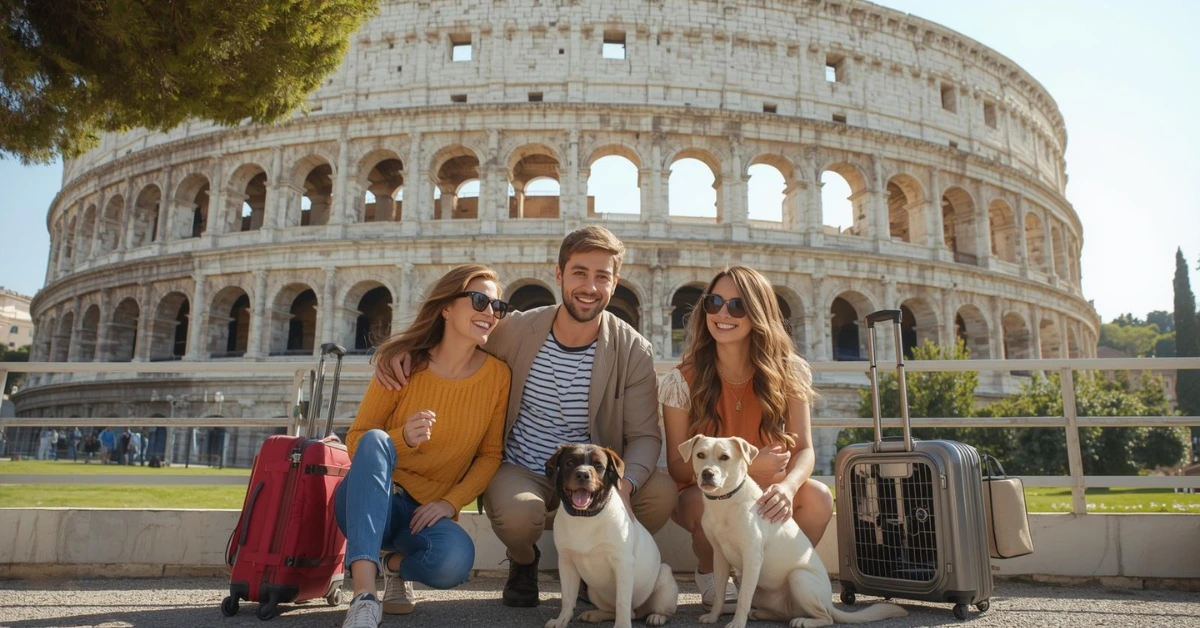Moving to Italy with your furry friends is totally doable, but you need the right paperwork and planning. Whether you’re bringing dogs, cats, or other pets, understanding Italy’s requirements will make your move smooth and stress-free. Plus, there are even some financial benefits when you combine pet ownership with relocating to certain areas of Italy.
Table of Contents
ToggleWhat Documents Do You Need to Bring Pets to Italy
Every pet entering Italy needs specific paperwork to get through customs without problems. The main document you’ll need is called an EU Health Certificate, which proves your pet is healthy and vaccinated. This certificate is different from a regular vet paper — it’s an official European Union form that must be filled out correctly.
Basic requirements for entering Italy with pets:
- ISO-compliant microchip (15 digits)
- Valid rabies vaccination
- EU Health Certificate signed by an accredited veterinarian
- USDA endorsement of the health certificate (for pets from the United States)
- Pet passport (if traveling from another EU country)
The microchip is super important and must be implanted before your pet gets its rabies shot. If you do it backwards, the rabies vaccination won’t count under EU rules, and you’ll have to start over. The microchip should meet ISO standards 11784 or 11785, which most modern chips do.
Entry Requirements for Pets in Italy
Italy follows EU-wide rules for pet entry, which are strict but manageable if you prepare in advance. Here are the essentials:
- Microchip
Your pet must have a 15-digit ISO-compliant microchip. Old tattoos are only accepted if applied before July 2011 and still legible.
- Rabies vaccination
This must be done after the microchip is implanted. The vaccine must be valid and at least 21 days old before travel.
- EU health certificate
In the U.S., this is issued by a USDA-accredited veterinarian and then endorsed by the USDA. Other countries have equivalent authorities. The certificate is only valid for 10 days to enter the EU.
- Tapeworm treatment
Not required for Italy, but some EU countries do require it for dogs. Check the rules if you’re connecting through another country.
- Age restriction
Pets must be at least 12 weeks old and vaccinated against rabies to travel.
Travel Logistics
Getting your pet from home to Italy takes some planning. Airlines all have slightly different rules, but here’s what you can expect:
Airline policies
Small pets (under 8 kg, including their carrier) can usually fly in the cabin with you. Larger animals almost always travel in the cargo hold. Always confirm with your airline before booking.
Carriers
Your pet will need an IATA-approved travel carrier. It should be sturdy and big enough for them to stand, turn, and lie down comfortably.
Booking early
Airlines only allow a limited number of pets per flight. If you wait too long, your pet may not get a spot, so it’s best to reserve early.
Layovers
If you have a layover in another EU country, your pet officially “enters” the EU there. That means customs and veterinary checks will happen at your first EU airport, not when you arrive in Italy.
Rabies Vaccination Requirements
Rabies vaccination rules for Italy can get confusing because they work differently than in the United States. Your pet must be at least 12 weeks old to get a rabies vaccine that Italy will accept. After getting vaccinated, your pet needs to wait at least 21 days before traveling to Italy. Some vaccines require a 30-day waiting period instead, so check with your vet about which type your pet received.
Here’s where it gets tricky: if this is your pet’s first rabies shot after getting microchipped, the EU calls it a “primary” vaccination. Even if your adult dog gets a 3-year vaccine, if it’s primary according to EU rules, it only counts for 1 year. You need to give your pet a booster shot within that year, or you’ll have to start completely over.
| Vaccination Type | Waiting Period | Validity Period |
|---|---|---|
| Primary (first shot after microchip) | 21-30 days before travel | 1 year only |
| Booster (shot within 1 year of primary) | Can travel immediately | 1-3 years per manufacturer |
The EU Health Certificate Process
Getting your EU Health Certificate involves several steps and must happen in a specific order. First, find a USDA-accredited veterinarian who knows how to complete these forms. Regular vets can’t just sign off; they need special accreditation. Your vet will examine your pet within 10 days of your arrival in Italy and complete the health certificate.
After your vet signs the certificate, you must take it to a USDA office for endorsement. This means a government veterinarian reviews everything and adds an official stamp and signature. For non-commercial moves (when you’re traveling with your pet), this endorsement must happen within 10 days of arriving in Italy. For commercial moves (when your pet travels separately), the endorsement must happen within 48 hours of your pet leaving the United States.
The health certificate is valid for different time periods depending on how you’re traveling:
- Non-commercial certificate: Valid for 30 days after your vet signs it
- Commercial certificate: Must be used within 48 hours of leaving the U.S.

Commercial vs. Non-Commercial Pet Travel
The EU has strict rules about how pets travel, and this affects which certificate you need and when you need it. Understanding the difference can save you time and money.
You can use non-commercial rules if:
- You or a family member/friend travels within 5 days of your pet (before or after)
- You’re bringing 5 or fewer pets
- You’re not selling or giving away your pet
You must use commercial rules if:
- You can’t travel within 5 days of your pet
- You’re bringing more than 5 pets
- The move involves selling, adopting out, or transferring ownership
Commercial moves are more expensive and have tighter deadlines, so try to travel within that 5-day window if possible. The non-commercial route gives you more flexibility and costs less.
Additional Requirements for Pets from the United States
Pets coming from the United States have some advantages because the U.S. is considered a “Part 2 Listed Country” by the EU. This means Italy recognizes that rabies is controlled in America, so you don’t need a rabies titer test (also called a serology test). This test costs around $200 and requires waiting 3 months after getting results, so skipping it saves time and money.
However, pets from “unlisted countries” (countries where rabies isn’t well-controlled) do need the titer test. If you’re moving to Italy from the U.S. but your pet recently visited a country on the unlisted category within the past 4 months, you might need the test anyway.
What member states require:
- Microchip before the rabies vaccine
- Rabies vaccine at least 21 days before travel
- Health certificate issued within the proper timeframe
- USDA endorsement with ink signature and embossed seal
- All previous rabies certificates if show continuous vaccination
Costs of Bringing Pets to Italy
Moving pets internationally costs money, and you should budget carefully. Airlines charge fees, and government endorsements aren’t free either. Here’s what to expect:
| Expense | Estimated Cost |
|---|---|
| EU Health Certificate (vet visit) | $150-$300 |
| USDA Endorsement Fee | $38-$173 |
| Airline Pet Fee (cabin) | $125-$200 |
| Airline Pet Fee (cargo) | $200-$1,000+ |
| Professional Pet Shipper | $2,000-$6,000 |
| Microchip (if needed) | $25-$50 |
| ISO-compliant Pet Carrier | $50-$250 |
Large dogs usually can’t fit under airline seats, so they travel in cargo or as checked baggage. Some airlines don’t allow pets in cargo during very hot or cold months, so plan your travel dates carefully. If your pet is a restricted breed or very large, you might need to hire a professional pet shipping company, which costs significantly more but handles all the logistics.
Pet Carrier Requirements and Travel Tips
Your pet needs an airline-approved carrier that meets International Air Transport Association (IATA) standards. The carrier must be hard-sided with ventilation holes on all sides, secure closures (not just clips), and enough room for your pet to stand up, turn around, and lie down comfortably.
Key carrier features:
- Hard plastic construction (soft carriers not allowed for cargo)
- Screw-bolt closures at all connection points
- Ventilation holes on at least three sides
- Water and food dishes that attach to the door
- “Live Animal” labels and arrows showing upright position
- Absorbent material on the bottom
Label your carrier clearly with your name, Italian address, and phone number. Include your flight information too. If your pet is traveling in cargo, you should also attach vaccination records to the outside of the carrier in a waterproof pouch.
Entering Italy: Airports and Customs
Not all Italian airports accept pets entering from non-EU countries. If you’re coming from the United States, your pet must enter through one of these international airports: Bologna, Milan, Pisa, Turin, or Rome. Venice also accepts pets if they’re traveling with their owners.
When you arrive, you’ll go through customs with your pet. Have all your paperwork ready:
- Original EU Health Certificate with USDA endorsement
- Rabies vaccination certificates
- Microchip documentation
- Proof of your travel dates (showing you traveled within 5 days of your pet)
Airport officials will scan your pet’s microchip to verify identity and check that all documents match. If everything is correct, you’ll be approved to enter Italy with your pet. If there are problems with paperwork, your pet could be quarantined, sent back to the United States, or in extreme cases, euthanized, all at your expense.
Getting an EU Pet Passport in Italy
Once you’re living in Italy, you should get an EU Pet Passport for your pet from an Italian veterinarian. This passport makes traveling within European Union countries much easier. Instead of getting new health certificates every time you want to visit another EU country, the passport serves as permanent documentation.
The EU Pet Passport includes:
- Your pet’s microchip number
- Description of your pet
- Your contact information
- Rabies vaccination history
- Record of any treatments (like tapeworm medication)
The passport is valid for your pet’s entire life as long as you keep rabies vaccinations current. Italian vets charge around €30-50 to issue the passport. You’ll need your original health certificate and proof of your Italian address to get one.
Breed Restrictions and Leash Laws
Italy has few breed restrictions compared to some countries, but you should know the rules. Venice specifically bans Rottweilers and Doberman Pinschers. Throughout Italy, certain breeds considered potentially aggressive must wear muzzles in public places and on public transportation. This includes Pit Bulls, Rottweilers, Doberman Pinschers, and Chow Chows.
Italian pet laws:
- Dogs must be leashed in public areas
- Muzzles required for certain breeds on public transportation
- All dogs need microchips and annual rabies vaccines
- Cats must stay indoors at all times
- You can’t leave pets tied up and unattended
These rules apply everywhere in Italy, so make sure you follow them. Fines for breaking pet laws can be expensive.
Would you like to read more about similar subjects? Take a look at our related articles here: Benefits of Small Municipalities in Italy, Italian Citizenship Through Your Child and Italian Citizenship by Descent.
Bring Pets to Italy Survey
1. Which of the following documents is required for bringing a pet to Italy from the US?
EU Health CertificateDriver’s License
Birth Certificate
2. When should the ISO-compliant microchip be implanted?
After rabies vaccinationBefore rabies vaccination
It doesn’t matter
3. What is the minimum age for a pet to travel to Italy?
8 weeks12 weeks
6 months
4. Where do small pets under 8 kg usually travel on an airplane?
Cargo holdCabin with the owner
Baggage claim
5. Which of these steps is part of getting a US pet’s EU Health Certificate?
Signed by any regular vetSigned by USDA-accredited vet and endorsed by USDA
Only fill it online
6. Pets from the US are considered:
Part of an unlisted countryPart 2 listed country
Not allowed
7. Which is NOT a requirement for an airline pet carrier?
Hard plastic constructionVentilation holes
Wheels for fast rolling
8. Which Italian pet law is TRUE?
All dogs must be leashed in publicCats can roam freely outdoors
Pets don’t need microchips
9. What is the typical cost range for a USDA endorsement of a pet health certificate?
$10-$20$38-$173
$300-$500
10. What does the EU Pet Passport include?
Microchip number, vaccination history, contact infoOnly microchip number
Only travel itinerary



